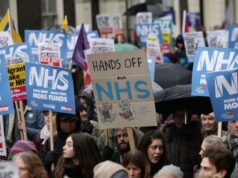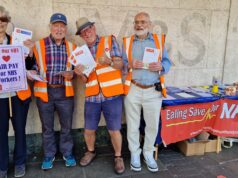The Downsizing of Ealing Hospital is a Past, Current and Future Threat
It is now apparent that the ‘hollowing-out’ of services at Ealing Hospital has been going on for over 10 years. This downsizing was brought into sharp focus when NHS North West London (NWL) published its ‘Shaping a Healthier Future’ (SaHF) plans in 2012. SaHF sounded the death knell for Ealing Hospital as a District General Hospital by mandating the closure of its Accident & Emergency (A&E) service in ‘at least three years’. It posited downgrading it from ‘Major Hospital’ status to ‘Local Hospital’ status.
Ever since the establishment of the Ealing Clinical Commissioning Group (ECCG) in 2013, this planning and purchasing body has shown little support for Ealing Hospital. In 2015 the ECCG closed down the hospital’s Maternity service and in 2016 it did away with Paediatrics.
In October 2014 Ealing Hospital Trust was dissolved and the hospital became a part of London North West University Healthcare Trust (LNWUHT). This Trust runs Northwick Park, Central Middlesex, St Mark’s and Ealing Hospitals. The Trust is headquartered at Northwick Park Hospital and during recent years the leadership of many healthcare services at Ealing Hospital has been transferred to Northwick Park.
On 26 March 2019, it was announced in Parliament that the SaHF plan was no longer supported by the Department of Health. The abandonment of this expensive failed plan seemed to suggest that Ealing Hospital’s A&E was saved and the downgrading/hollowing-out of Ealing Hospital would be terminated. However recent conversations with Ealing Hospital consultants along with information leaked from NHS NWL suggest otherwise.
When experienced professional staff leave Ealing Hospital they are often not replaced.
Incredibly there is no-one on-site who manages Ealing Hospital. Ealing Save Our NHS (ESON) asked LNWUHT bosses on 21 June 2019 for a list of services available at the hospital along with details of the level of service (e.g. consultants, surgery, specialised nursing). ESON asked for this as this information is not available on any NHS website. If patients have a right to choose where they are treated, they need to know where treatment is available! Three weeks on, the list has not been received by ESON.
At the June meeting with LNWUHT bosses, ESON asked for a copy of the post-SaHF plan for Ealing Hospital. No such plan exists but one is planned. September 2019 was the date promised for this plan. Apparently there are intentions to introduce some ’specialised services’ at Ealing Hospital. This same phrase and intention was voiced by Mark Easton, the NHS NWL boss at his meeting with ESON on 8 July 2019.
ESON made it clear to LNWUHT and NHS NWL bosses that nothing less than a development plan and formal re-launch of Ealing Hospital was needed.
If all the new flats being built and planned to be built in Ealing over the next 10 years ever get finished and occupied, the number of Ealing residents will rise from 345,000 now to over 400,000 by 2030. Not to have a fully functioning, sustainable major hospital in Ealing to service all these residents would be irresponsible and utterly shameful.
NHS NWL Proposes a Bewildering Array of Organisational Changes: Local Authorities are Expressing Significant Reservations
On 28 May 2019, NHS North West London (NWL) published a ‘Commissioning Reform’ paper on why replacing its eight local CCGs with one regional one was such a good idea. On 26 June 2019 an NHSE paper on Integrated Care System (ICS) design was published. On 10 July 2019 I was sent a set of NHS NWL slides the contents of which were an attempt to put more flesh on the bones of the May ‘case for change’ paper.
Feedback also exists from leaked comments from NHS NWL staff on 12Jjune 2019 and Local Authority Councillors speaking at the 21 June 2019 North West London Joint Health and Scrutiny Committee (JHOSC). At the JHOSC, Councillors expressed a wide range of concerns which included inadequate time to assimilate the changes for a 1 April 2020 start date, financial risks, budget organisation, how it will actually work in practice, cuts to services, no business case and staffing uncertainties. The most vociferous Councillors were those representing Hammersmith & Fulham, Hounslow, and Kensington & Chelsea. Shamefully no Ealing Councillors could be bothered to attend the meeting. Ealing Save Our NHS (ESON) met with NHS NWL supremo Mark Easton on 8 July 2019 and quizzed him on what and why was being proposed.
Why the Changes?
The overt reason for all the proposed changes is for NWL to comply with the January 2019 NHSE Long Term Plan (LTP). The LTP preaches that if care organisations work together then, as night follows day, we will enjoy improvements to our health provided by ’co-ordinated efficient services’.
However, surely with NHS Trusts and borough CCGs in deficit the changes must be driven by the desire to more successfully control costs? ‘Fixed (price) contracts’ was the term used by Mark Easton at the ESON meeting. The current ‘payment by results’ approach puts the incentives in the wrong place according to Mr Easton..
Back to the ‘working together’ approach – this is completely at odds with the ‘working apart’ approach of separating NHS purchasing from care service suppliers. This ‘market’ approach is one of the bedrocks of the 2012 Health & Social Care Act. One can only presume that after more than five years trying to get the separation/market approach to work it’s now deemed to be a failure.
What Are the Changes?
The first thing that strikes me is the high number of management bodies which will be created and will have to be maintained. Here’s a flavour:
+ Integrated Care System (ICS) Board
+ Clinical Commissioning Group (CCG) Governing Body
+ STP Partnership Board
+ ‘Place Teams’ – 8 of them
+ ‘Local Committees’ – 8 of them
+ Integrated Care Partnerships (ICPs) – 8 of them
+ Primary Care Networks (PCNs) management teams – at least 47 of them.
To unpack some of the new jargon, ‘Place’ means borough. ’Local Committees’ are borough subcommittees of the new CCG and have delegated commissioning authority. Each of the ‘Place Teams’ report to its borough Local Committee. It’s really unclear as to what the Place Teams will actually do
It is clear that ICPs will not exist as from day 1 (irrespective as to whether this is April 2020 or April 2021). Each borough ICP will be ’developed’ by the borough Local Committee. The future goal for the Local Committees is that they will be ‘absorbed’ by their ICP.
There are three choices as to how a borough Local Committee might operate. Basically this is all about how the NHS and Local Authorities might work together. Crudely the options are:
- Separate plans and separate budgets
- A single plan and separate budgets
- A single plan and a single budget
It seems that in NHS South West London option 2. is favoured, whilst in NHS South East London boroughs are likely to choose different options.
Some of the proposals are extremely difficult to understand. A flavour of this is as follows:
Under the slide heading ‘Primary Care at NWL and Place’ it states ‘This could mean in practice: Central NW London team supported by locally based primary care teams’.
One has to ask what teams are these? Is the ‘Central NW London team the new CCG – or something else? What are these ‘locally based primary care teams’? Are they Place Teams, Local Committees PCN teams or ad hoc teams?
The reader is then presented with two options:
‘A single primary care commissioning team, for NWL, delivered by primary care leads (from CCGs), the NHSE commissioning/ finance teams, Enhanced Services team etc., to agree service plans, outcomes and financial envelope with local integrated care partnership (ICP) teams’.
For a start under the new reform regime there won’t be ‘CCGs’ – only just one at regional NWL level. What is ‘Enhanced Services team’? Is this pharmaceutical (introduced in 2013) and/or Directed Enhanced Services e.g. a PCN contract – introduced on 1 July 2019?
The other approach option is:
‘CCG-based teams to commission integrated care at a place-level as the PCNs mature alongside the core general practice commissioning requirements, overseen by local PCC and /or ’Committee-in-Common’. This model enables local ICPs to evolve alongside local general practice and PCN development over the 5 years of the PCN contract’.
‘Committee-in Common’ is a confusing and surreal concept. It’s where two or more organisations meet in the same place at the same time. However the two organisations remain distinct and (if the committee is decision making) take their own decisions. It’s hardly an example of progressive ‘working together’.
I have been researching/writing about NHS plans, processes and legislation in some detail now for over six years. I am also reasonably well educated but I have to say that I do not have the faintest idea what either of these options actually means.
There are plenty of references to the NHS NWL Sustainability & Transformation Plan (STP), parts of which are obsolete (e.g. the closure of Ealing Hospital A&E). Mark Easton did accept that following the demise of SaHF and the requirements of the January 2019 NHSE Long Term Plan (LTP), NHS NWL would adopt a single new plan – the NHS NWL LTP – some time later this year.
There is plenty of ‘Shaping a Healthier Future’ type aspirational verbiage including the old chestnut of ’more than 30% of patients in Acute hospitals shouldn’t be there’. However there’s nothing in the current reform proposals that reflects the chronic shortage of doctors, nurses, consultants and care support workers. No reference is made to the enormous building maintenance backlog and the desperate need for capital so that many of the NHS NWL hospitals don’t fall apart. Local Authority Social Care hardly gets a mention.
How Do NHS Staff Feel About the LTP and NWL’s ‘Commissioning Reform’ Proposals?
On 24 June 2019 the Doctors’ Union – the British Medical Association (BMA) – voted to oppose the NHS LTP describing it as ‘a plan for a market-driven healthcare system’. The BMA also opposed the shift of care from hospitals to the community. The BMA, formed in 1832, has over 100,000 members.
On 12 June 2019, some 500 NHS NWL staff were treated to an away day at which the NWL LTP/ reform proposals were presented to them. A whistle-blower released on-line comments and reactions to the slide show and the questions and answers sessions. These 100+ comments and responses from the staff revealed an unhappy workforce worried about their jobs, redundancy, incomplete information on how the reform might actually work, stress, bullying, overwork, need for a single IT system, unrealistic QIPP plans, vacancy and recruitment freezes, and money wasted on contractors, interims, agency staff, project managers and on the away-day itself! There is also an intriguing comment about Hillingdon is not being involved in the restructuring.
Public Consultation and Local Accountability
There are plenty of references to ‘engagement’ with key stakeholders in the NWL material, but there is no commitment whatsoever to formal public consultation on the reform plan. Twice I have asked Mark Easton face-to-face about whether ICPs will meet in public. Neither time did I get a straight answer. It’s probably important to discover whether the ICS, ICPs, Place Teams, Local Committees and PCNs will meet in public. If it’s just the NWL CCG which meets in public, then local activist organisations – like ESON in Ealing – will find it very hard to hold the NHS to account locally. This is especially true for Ealing as currently its only hospital does not hold performance review/information meetings in public at the hospital.
What Might Happen Next?
‘Key stakeholders’ are currently being ‘engaged’ and ’final engagement events to design proposals’ are planned for August 2019. Comments are welcomed up to 24 August 2019. Delegated budgets, management costs, outline structures and staffing intentions are being assembled and will be added to the reform plans. The eight statutory NHS NWL CCGs will be asked to approve the reform plans by October 2019. If all the CCGs give the green light then ‘change management’ and ’implementation’ will follow with the NWL preferred target start date for ’merge CCGs’ in April 2020.
There’s plenty that could de-rail this chain of events. Candidates for disruption include one NWL CCG saying ‘no’, a new Prime Minister and Cabinet, a no deal Brexit, a new Brexit referendum and a new Labour Government.
No ICP contracts have been signed and although 14 ICSs appear to ‘exist’ on paper surely none of them are single CCG post-LTP entities and will only be legitimised and formally activated when legislation to amend the 2012 Health & Social Care Act comes into force. The much trumpeted pioneer ICSs at Greater Manchester and at Dudley have been stalled for months. Dudley doesn’t even feature in the NHSE 14 ‘plastic’ ICSs! Parliament has been in a state of chaos for months and this chaos is likely to continue for many more months. My bet is that changes to the 2012 Act are unlikely to take place any time soon.
m




